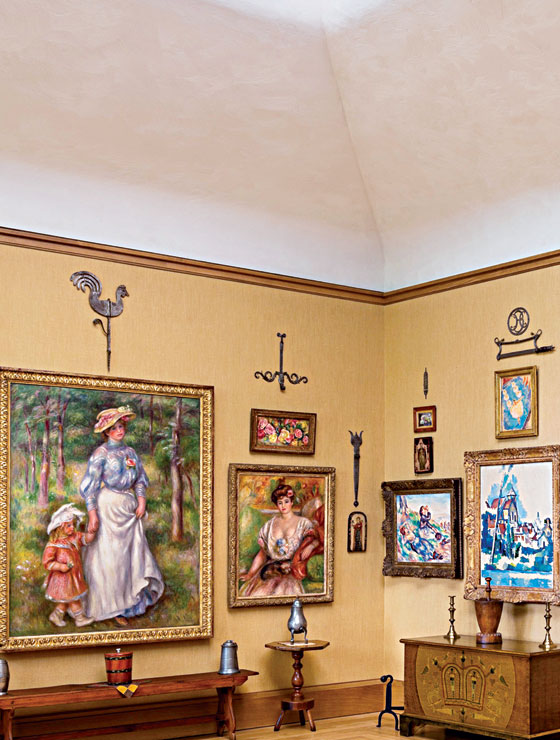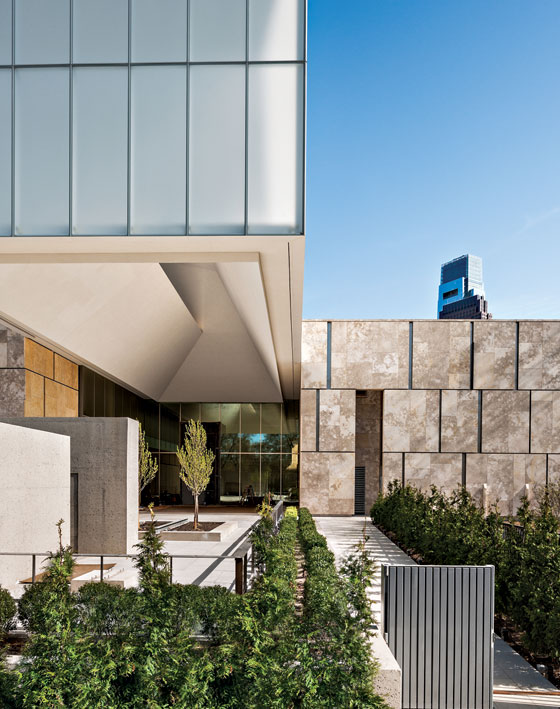
When the pharmaceuticals magnate Albert Barnes died in 1951, he left his art collection in trust with a rigid stipulation: that it remain exactly as it hung in a jam-packed building in Lower Merion, Pennsylvania. A decade ago, faced with maintenance costs and severe crowding and parking problems, the Barnes Foundation began planning a move to downtown Philadelphia. Amid lawsuits and protests, the relocation was approved in 2004, and Barnes’s eccentric installation has been replicated in the new building. It opens on May 19.
Justin Davidson:
Architecture has no problem with megalomania. The cocktail of delusion, vision, ambition, and money has yielded all sorts of juicy projects: a national library for a Kazakh potentate, the world’s tallest skyscraper in a desert kingdom, a private spaceport in New Mexico. By those standards, the new home of the art collection amassed by an odd pharmaceutical tycoon is a model of rational sobriety. The building’s design is exquisitely tasteful, the grounds strike a balance between comfort and formality, and the masterworks inside are all flatteringly lit. Yet the new Barnes Foundation building still gives off the whiff of one man’s inextinguishable weirdness.
The story of this place is tormented and baroque. Barnes assembled a large and uneven treasure-house of paintings, metalwork, furniture, and plants, and then spent a lifetime (until his death in 1951) trying to perpetuate his control. He dictated who could see his collection and when, and how it was housed, hung, and reproduced. He’s still at it. Even though a judge finally allowed the move from Merion, Pennsylvania, to downtown Philadelphia, the foundation is obliged to retain Barnes’s dense and obsessively symmetrical arrangement. Honoring his eccentricities made sense in his dark and creepy house; here, they have become irksome.
The husband-and-wife architectural team of Tod Williams and Billie Tsien has done a virtuosic job of dealing with constraints that go well beyond Barnes’s founding orneriness. They were handed a skimpy, wedge-shaped plot of land along the Benjamin Franklin Parkway, a cultural corridor with all the friendliness of a parade ground. The juvenile detention center that previously occupied the site was not entirely out of place. On a slight rise above the road, the architects managed to fit a garden and a knockoff of the suburban gallery in Merion, plus offices, a conservation center, a café, and shelter for the 250,000 visitors a year that the move is expected to attract.
The project vibrates with ambivalence: about Barnes’s vision, about appealing to the broad public that he both sought and disdained, about becoming an urban institution, about embracing flexibility and change. Williams and Tsien have untangled this ganglion of mixed feelings with therapeutic sensitivity. Instead of placing a ceremonial entrance grandly on the boulevard, the building turns demurely away, presenting its patchwork façade of blond stone slabs from the Negev desert. OLIN, the landscape-architecture firm founded by Laurie Olin, invites visitors along a zigzagging pathway, past a succession of water features whose plashing eases the transition from city to cloister. By the time the entrance appears before you, you’re practically inside.
The complex is a basilica of sorts, with the galleries to one side, the administration on the other, and in between a high, vaulted nave airy enough to inoculate visitors against the claustrophobia to come. This could have been a monstrous space, vast and reverberant and forbidding. But the architects lidded it with a box of translucent glass. Sunlight flows through a hidden skylight of frosted panes, ricochets off the folds in a shell-like vault, and drops to the ground serene and glare-free. Looking at art is an intense experience, and this court, sheltered by the great glowing cantilever that hovers overhead, gives visitors a soothing place to pause.
Here, stone and fabric seem to merge. Wall hangings of pale silk and wool, designed by the textile artist Claudy Jongstra, resemble travertine, while the desert stone of the walls, naturally mottled in pinks and yellows, looks pliable and warm. Workers gouged the limestone in what Williams and Tsien call a cuneiform pattern, and the panels do resemble massive tablets marked with runes. You might want to run your fingers over those hand-carved ridges; a good museum is art you can touch. Tactile details animate the stairwells, too: a narrow vertical window that evokes a medieval tower’s arrow slit, a staircase that hugs one wall and detaches from the other so that it appears to float.
Finally, you step from this preparatory chain of gardens, vestibules, anterooms, and forecourts into the congested heart of the institution, and it’s a shock. Suddenly, you are overwhelmed by art—great paintings, middling paintings, paintings interspersed with metalwork in galleries cluttered with furniture. Six or eight people at most can jam into one of the smaller rooms, hurriedly contemplating the serried pictures. In the largest gallery, one of Cézanne’s “Bathers” and Seurat’s “Models” hang eight feet up, their greatness barely detectable without binoculars. The curators are powerless to bring them down to eye level, and though Williams and Tsien tweaked windows, reshaped ceilings, and simplified moldings, they couldn’t smooth over the place’s inherent disjunctions. In the end the architects have delivered the best compromise that this peculiar project allowed: a ravishing reliquary for a dead man’s embalmed dreams.

Jerry Saltz:
After a half-century of misguided intentions, a will interpreted every which way, deteriorating infrastructure, neighbors wanting it gone then wanting it back again, and outrage over the thought that art should ever be viewed under any rules but its owner’s, one of the greatest and Frenchest and most oddly displayed collections of post-Impressionism and early Modernism is back on view. The roughly 800 paintings in the Barnes collection have been reinstalled precisely as Albert Barnes hung them, tightly crowded and flanked by odd bits of hardware and other hoarded artifacts, in a meh-looking new building on Philadelphia’s Benjamin Franklin Parkway. Although the motives behind the move may have been all too human and therefore tragic, and those involved may look back in anger, the effect is epic. After being virtually impounded, cut off from the outside world by its brilliant and dictatorial connoisseur-owner who forbid it ever to be moved, loaned, or even sketched, this lost tribe of paintings and sculptures has been reunited with the family of art. Almost.
I’ll explain that “almost” in a minute. First let me report that the art in the Barnes Collection has never looked better. My trips to the old Barnes were always amazing, but except on the sunniest days, you could barely see the art. The building always felt pushed beyond its capacity. Crowds were common because of the restricted hours. You had to book way in advance and felt rushed because of the pileup behind you. (The new Barnes, by contrast, is open six days a week, eight hours a day, plus Friday nights.) In the new building, highly controlled natural light and ultraprogrammed, unobtrusive artificial lighting bring things out of these pictures that have been dormant or invisible. Rooms that are no bigger seem bigger; time slows as gaggles of works unfurl into constellations of changing configurations and overlapping meanings. Color bursts forth. The blues of Cézanne, once indistinguishable from the greens, come crashing back. Schisms and rifts between things reappear. The lush brushwork of Soutine, Manet, Degas, and Courbet glows red-hot. The close-toned, backlit majesties of Rousseau rise and loom as never before. Matisse’s paintings return to being fiery impassioned tapestries. In one painting, Picasso’s 1903 The Ascetic, a gaunt, opalescent man against a Mediterranean blue ground radiates like a living phosphorescent organism, and he may change the molecular structure of Philadelphia (I imagine the Phillies gathering in front of it, drawing mystic energies). It spellbinds. Many of the 181 Renoirs—181!—look structurally august, not just cheesy. Rather than madly clashing, Van Gogh’s palette turns finespun, exquisite, and controlled.
Which brings us closer to that “almost.” Albert Barnes had a preternaturally great eye, but he had revolutionary, and often flaky, ideas about how art must be seen. Shunning hierarchy, style, chronology, artist, dimension, or any system at all, the Barnes collection is a visual language unto itself. Call it Smorgasbord Mundo. The paintings are wedged into 24 small galleries with vast amounts of folk art, crafts, New Mexican retablos painting, Pennsylvania Dutch furniture, Tang-dynasty Bodhisattvas, archaic Greek incense burners, Roman busts, paper silhouettes, pewter pitchers, iron pincers, cookie-cutters, coffeepots, weather vanes, horseshoes, letter openers, lock mechanisms, one of the world’s outstanding collections of wrought iron, thousands of other objects including over 200 pieces of Native American jewelry and textiles, and 125 African art pieces and masks. It’s ruthless, unrelenting, almost inhuman.

As a result, the Barnes is not a collection so much as an unyielding optical labyrinth—a Gesamtkunstwerk, or total work of art unto itself, that can change the way you think about what you see. It can also blind you. With no retinal breathing room, no psychic rests, no spaces of silence, you can find yourself rushing past masterpieces, overloaded by the optical onslaught. As much as I love the Barnes, I don’t want any other museum on Earth installed this way. No matter how greatly you admire it, you have to admit that the artists who made this art might be horrified by how their works have been used. I imagine the ghost of Georges Seurat trying to remove his giant masterpiece series “Models” from its spot eight feet above the floor. (I picture Renoir’s ghost hovering nearby, gloating, and I flinch a little.)
Yet the madman was onto something. In one gallery I boggled at a Ptolemaic-period Egyptian bas-relief of a woman squatting with her knees facing one direction, her trunk seen full on, her head facing another. Then I saw the Egyptian pose in Matisse’s monumentally powerful 1907 Red Madras Headdress, picturing a woman in the richest blue-and-maroon dress ever. Then it recurred in several Modigliani portraits, then abstractly in a Cézanne still life seen simultaneously from left, right, above, below, and straight on. Then it all exploded in Picasso’s 1907 proto-Cubist portrait of a woman whose presence would end up squatting like the Egyptian figure in his Les Demoiselles d’Avignon. That never would have happened anywhere but here.
Soon the dust will settle, the feuds will fade, and art will do what it does. Till then, remember this: Owners of art are temporary caretakers. Their wishes are not to be sacrosanct in perpetuity. The move of this singular jewel in the crown to a more accessible location, into a far better-equipped, much more flexible building, allows this monumental testament to art’s possibilities to shine forth more magnanimously and generously than ever before. When art wins, everyone wins. Even Albert Barnes.